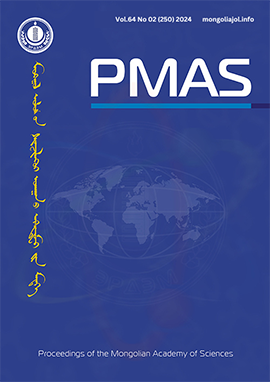Study of the strong coupling constants, α<sub>s</sub> (q<sup>2</sup> ) of π- and K<sup>0</sup> mesons from π<sup>-</sup>+p and π<sup>-</sup>+C interactions at 40 GeV/c
DOI:
https://doi.org/10.5564/pmas.v64i02.3650Keywords:
mesonsAbstract
This paper is devoted to the production of π-and K0 mesons from π-+p→π-+X and π-+C→π-,K0+X interactions at 40 GeV/c as a function of the square of four momentum transfer. The cut parameter of the strong coupling constant is taken as Λac2=ma2+mc2. Values of the strong coupling constant are then compared to leading-order and next-to-leading-order perturbative QCD calculations for the first time. Agreement between the experimental data and theory is good, thus providing a precision test of QCD at large momentum transfers (q). The strong coupling constant αs is extracted as a function of q, showing a good agreement with the renormalisation group equation and with previous analyses. As the momentum transfers increases, the running coupling constant decreases. For each high-energy interaction, a quantity called the cut parameter is chosen differently depending on the secondary particles produced by the reaction. For each high-energy interaction, a quantity called the cut parameter is chosen differently depending on the secondary particles produced by the reaction.
Downloads
888
References
Perkins. D.H (Oxford U.). Introduction to high energy physics, Published by: Cambridge Univ. Press, Cambridge, UK (2000) p. 426
Blokhintsev. D.I. On the fluctuations of nuclear matter, Sov.Phys.JETP 6 (1958) 5, 995-999.
Baldin A.M. Physics of relativistic nuclei, Part.Nucl.1977, V.8, part 3, p429.
Greiner.W. Quantum chromodynamics, Published Springer Press, Berlin, Germany (2002) p. 551.https://doi.org/10.1007/978-3-662-04707-1
Aad.G, Abbott.B, et al. Determination of the strong coupling constant from transverse energy-energy correlations in multijet events at √(s )= 13 TeV with the ATLAS detector, Published: Jul 11, 2023, https://doi.org/10.1007/JHEP07(2023)085
Downloads
Published
How to Cite
Issue
Section
License
Copyright (c) 2024 Narankhuu Khishigbuyan, Tseepeldorj Baatar, Alexandre I. Malakhov, Baatar Otgongerel, Maamuu Sovd, Ravdandorj Togoo, Gombojav Sharkhuu, Mordorj Urangua

This work is licensed under a Creative Commons Attribution 4.0 International License.
Copyright on any research article in the Proceedings of the Mongolian Academy of Sciences is retained by the author(s).
The authors grant the Proceedings of the Mongolian Academy of Sciences a license to publish the article and identify itself as the original publisher.

Articles in the Proceedings of the Mongolian Academy of Sciences are Open Access articles published under a Creative Commons Attribution 4.0 International License CC BY.
This license permits use, distribution and reproduction in any medium, provided the original work is properly cited.

